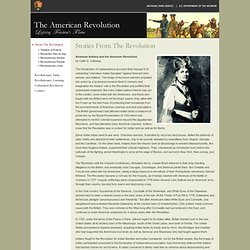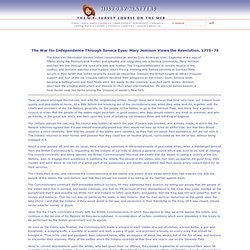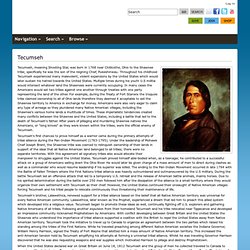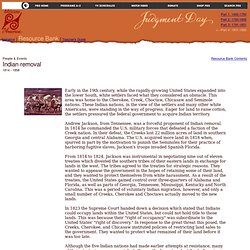

Lewis and Clark . Native Americans. While Lewis and Clark were the first Americans to see much of what would become the western United States, those same lands had long been occupied by native peoples.

Over the course of the expedition, the Corps of Discovery would come into contact with nearly 50 Native American tribes. Quickly, the captains learned how many different definitions there really were for the word “Indian.” The Mandans lived in earth lodges, farmed corn and were amenable to trade with America. The Teton Sioux slept in tepees, hunted buffalo and guarded their territory fiercely against anyone who passed through, whether foreign or Indian. Some tribes had never seen a white or black man before Lewis and Clark. The American Revolution. American Indians and the American Revolution by Collin G.

Calloway The Declaration of Independence accused King George III of unleashing "merciless Indian Savages" against innocent men, women, and children. The image of ferocious warriors propelled into action by a tyrannical monarch fixed in memory and imagination the Indians' role in the Revolution and justified their subsequent treatment. The War for Independence Through Seneca Eyes: Mary Jemison Views the Revolution, 1775-79. The American Revolution divided Indian communities as well as Euro-American ones.

Captured at the age of fifteen along the Pennsylvania frontier and adopted and integrated into a Seneca community, Mary Jemison watched the war through the eyes of a wife and mother. The Iroquois attempted to remain neutral in the conflict, and Jemison watched tribal leaders return from a meeting with Patriot colonists at German Flats, secure in their belief that Indian neutrality would be respected. Instead, the British sought to attract Iroquois support and four of the six Iroquois nations declared their allegiance to the crown. Soon, Seneca lands became a battleground and their fields were laid waste by the colonists’ scorched earth tactics. Jemison described the ensuing destruction and disease in 1823 when she related her life story to James Seaver, a local doctor near her home among the Iroquois of western New York. "Brother, you have merited death! "Brother! Source: James E. Tecumseh - Ohio History Central - A product of the Ohio Historical Society.
Tecumseh, meaning Shooting Star, was born in 1768 near Chillicothe, Ohio to the Shawnee tribe; specifically he was the son of the reigning Chief, Pukeshinwau.

Throughout his childhood Tecumseh experienced many malevolent, violent expansions by the United States which would later sustain his hatred towards the United States. Multiple times during his youth U.S militia would intersect whatever land the Shawnees were currently occupying. In many cases the Americans would set two tribes against one another through treaties with one party representing the land of the other. For example, during the Treaty of Fort Stanwix the Iroquois tribe claimed ownership to all of Ohio lands therefore they deemed it acceptable to sell the Shawnee territory to America in exchange for money.
Americans were also very eager to claim any type of acreage so they plundered many Native American villages, including the Shawnee's various home lands a multitude of times. See Also References Hurt, R. Indian-Pioneer Papers Collection. Untold Stories Of The Second World War: The Navajo (Part 2) The American Revolution. Indian removal. Early in the 19th century, while the rapidly-growing United States expanded into the lower South, white settlers faced what they considered an obstacle.

This area was home to the Cherokee, Creek, Choctaw, Chicasaw and Seminole nations. These Indian nations, in the view of the settlers and many other white Americans, were standing in the way of progress. Eager for land to raise cotton, the settlers pressured the federal government to acquire Indian territory. Andrew Jackson, from Tennessee, was a forceful proponent of Indian removal. In 1814 he commanded the U.S. military forces that defeated a faction of the Creek nation. From 1814 to 1824, Jackson was instrumental in negotiating nine out of eleven treaties which divested the southern tribes of their eastern lands in exchange for lands in the west.
In 1823 the Supreme Court handed down a decision which stated that Indians could occupy lands within the United States, but could not hold title to those lands. Previous | next. The War for Independence Through Seneca Eyes: Mary Jemison Views the Revolution, 1775-79.